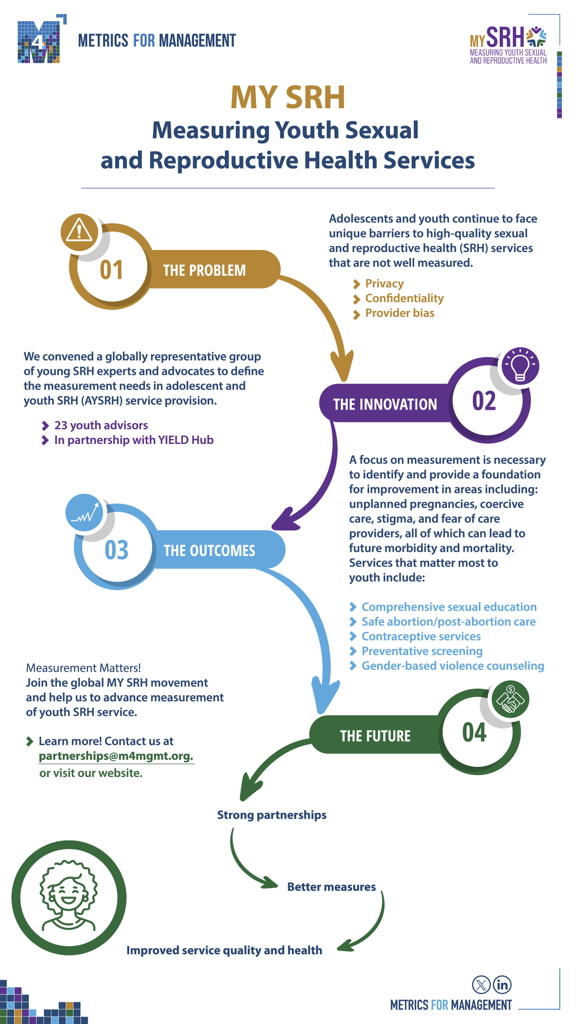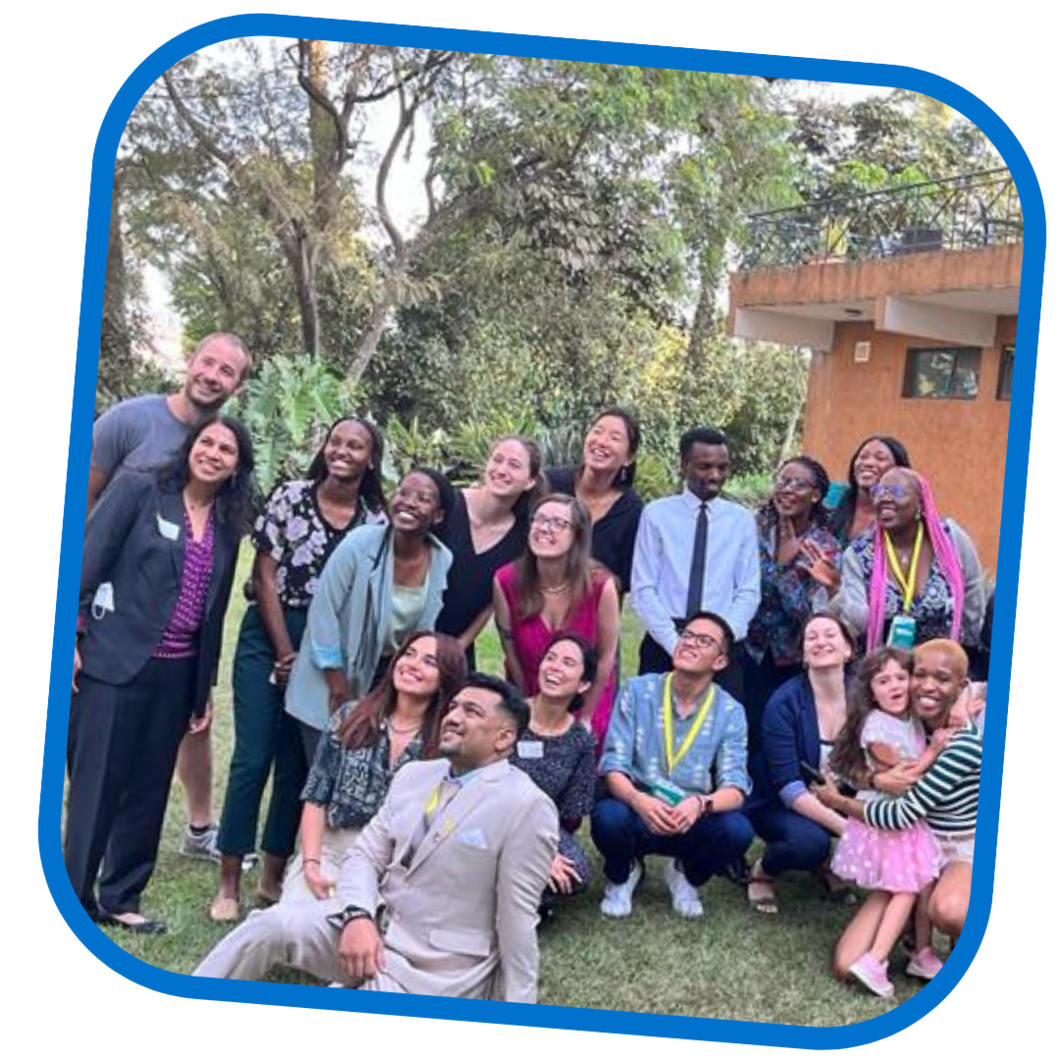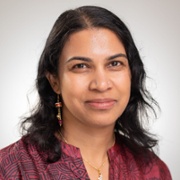Engaging Youth to Measure Sexual Reproductive Health Quality and Access: In Conversation with Nirali Chakraborty
By Sarah Han, MPH, Youth-Centered Health Designer, ETR and Nirali Chakraborty, Ph.D. Chief Strategy Officer & Director of Research, Metrics for Management (M4M)
September 18, 2023
This summer, Sarah Han, Youth Centered Health Designer at ETR, joined the Measuring Youth Sexual and Reproductive Health (MY SRH) Initiative at the Women Deliver 2023 conference in Kigali, Rwanda. Led by Metrics for Management (M4M), this global advisory group of young professionals convened to tackle the question,
“How can we dismantle the barriers that hinder young people's access to respectful, high-quality SRH services?”
In this conversation, Sarah is joined by Nirali Chakraborty, Chief Strategy Officer and Director of Research at M4M to learn more about this critical work in global youth SRH:
Sarah: Thank you so much for speaking with me today, Nirali. I’m so grateful to you and your team for organizing this important, youth-centered space and to be connecting with you again now.
To start, can you tell me about your background and how you came to be Chief Strategy Officer at M4M?
Nirali: The part about public health that is most interesting for me was around helping people get better care. I'm not a physician or a lab scientist, so the way I help people get better care is by thinking through improving health care systems. I worked as a research advisor for a large international nonprofit, focusing on their reproductive health portfolio. Through that work, I was part of a process to design simple measures that organizations and others could use to assess their health care.
That effort led to the creation of M4M, which, at the core, finds ways for healthcare organizations and service providers to see how they can provide better care. We create tools for them to measure their care in a way that is accessible and actionable.
Goals of the MY SRH Initiative
Sarah: The goal of the MY SRH Initiative is to create an evidence-based tool for assessing the quality and accessibility of SRH services to ultimately improve those services for young people. Can you tell us more about this initiative?
Nirali: We wanted to focus on measuring the factors that are most pertinent to improving the quality and access of care for young people because access challenges for young people seeking SRH persist. And we embarked on a process that's lasted the past few years, including conducting a literature review and interviews and focus groups with the youth advisors and providers at service delivery organizations.
We found a set of areas that needed better measurement. We knew that those areas, if better measured, could improve service quality for young people seeking SRH care. And then we said, we don't want to keep going down this road by ourselves. The MY SRH Initiative really was about making the effort more holistic and youth-centered. We were fortunate to be able to host this convening at the Women Deliver conference in Kigali. The purpose of MY SRH convening was to set the stage for what we had done so far and see from our perspective how that resonated with you and the 22 other youth advisors from across the globe, all of whom bring lived experience and work experience into this field.
Through the convening, we gained greater clarity into what the concepts of privacy, confidentiality, and provider bias mean to the youth advisors and how it manifests. If you don't have good privacy or confidentiality if you have biased providers, what does that mean for health outcomes of care? It's important to be able to marry the experiences with the literature to tell a story that's more comprehensive.

Centering Youth Engagement
Sarah: Absolutely. It can be difficult to not only do the research and find the evidence base but also actually create spaces for those stories to align and triangulate the data with people's day-to-day lived experiences. On that note, what is the role of youth engagement in global SRH, and what does it mean to be youth-centered?
Nirali: I think I'll answer your question in two parts. First, to think about youth engagement and SRH more broadly, my impression is that the SRH world is doing quite a good job at engaging youth in several different spheres, including projects and initiatives that use human-centered design principles to help co-create the solutions to overcome the barriers that young people are facing. These solutions range from access points for contraceptives to the language that's utilized in clinics to the design of the spaces. Also, there are now more mobile –technology-based ways that young people can get access to information than ever before. And so many of these tools are being created by young people themselves – I think that also that's a great step forward!
However, there are still spaces where youth inclusion is lacking. And some of those spaces hold the most potential for improving access to SRH care. I think that’s mainly in the public sector. Especially in lower and middle income countries, where the public sector provides most of the care, public sector facilities are slow to adjust and have a lot of systemic impediments to making care more accessible to young people. That's a space where there's still an opportunity for growth, but there's a lot of innovation coming from the private sector and the not-for-profit sector.
Secondly, what does it mean to be youth-centered in measuring the accessibility, delivery, and quality of health services? How are youth included in the evaluation? That's lagging because it is difficult for a lot of reasons. How do we best involve young people who have a lot to offer but also have a lot to learn? How do you involve them in a way that is equitable while being efficient? I mean, those are real challenges that we face.
So, I think there is a really large global movement around creating better indicators for adolescent health services. However, one of the things that struck me about this movement is that some folks are creating measures about young people without involving young people at all. We saw this and said, “We think we can do better.” And that’s what we’re attempting to do. We want to do this in a way that’s authentically youth-centered. We really want to walk the walk with the MY SRH initiative. We were able to walk the walk better because we partnered with Yield HUB, as they’re a youth organization focusing on better youth engagement.
The Value of Youth Expertise
Sarah: Through this experience and working with clinicians, lawyers, and advocates from all over the world who were my age and doing amazing work, I realized how much power there is to be both a professional working in public health and young enough to be able to relate to the younger people with whom we engage directly. The experience of being included in this work truly helped me kind of embrace the power of being a young professional. Normally, society tends to think the younger you are, the less you are an expert. The MY SRH convening really flipped that on its head in an empowering and important way.
Nirali: We really learned so much from the MY SRH youth advisors. One of the most fascinating findings from our convening was how critical comprehensive sexual education is! I think normally, when you think SRH, the first thing you think of is contraception. The second might be abortion. Comprehensive sexual education falls somewhere later down that list, if it's even on the list at all. I think it was such a powerful thing that came out of this convening.
Sarah: Yes! I was also surprised by the results of that ranking activity. Having all these people from all over the world, from different walks of life, with different professions agree resoundingly that comprehensive sex ed is the priority was really powerful because young people don’t know what services they have a right to unless they have access to that education.
Nirali: This aligns with the shift in the field of SRH and global health in general. In the last several years, there's been a much larger emphasis on person-centered care. It conceptually stems from the fact that healthcare is a human right. SRH care is a human right. More and more, we’re taking that human rights-based approach to care.
I think that that's a real shift because it shifts the way that you have to think about how you measure things as well. How do you measure access to subpar care, for example? Low-quality care is not good enough. What we really want to understand is access to high-quality care because that's what is our right, all of us.
The Future of the MY SRH Initiative
Sarah: I have goosebumps! Yes, absolutely. On that note, what's next for the MY SRH initiative?
Nirali: We want to try to ride this wave as long as we can. Our next steps are to continue to promote the great work that came out of the initiative with individuals and organizations. Through the MY SRH initiative, we have identified what aspects of privacy, confidentiality, and provider bias are most important to measure to find out how to dismantle barriers to high-quality youth SRH care. With this and M4M’s expert metrics development process, we hope folks will want to partner with us and help us move this work forward.
Sarah: Thank you again for sharing your insights and the important work of M4M and the MY SRH Initiative.
Sarah Han (she/her/hers) is a Youth-Centered Health Designer at ETR. She can be reached sarah.han@etr.org.
Nirali Chakraborty (she/her/hers) is Chief Strategy Officer and Director of Research at Metrics for Management (M4M) and can be reached at nirali@m4mgmt.org.





